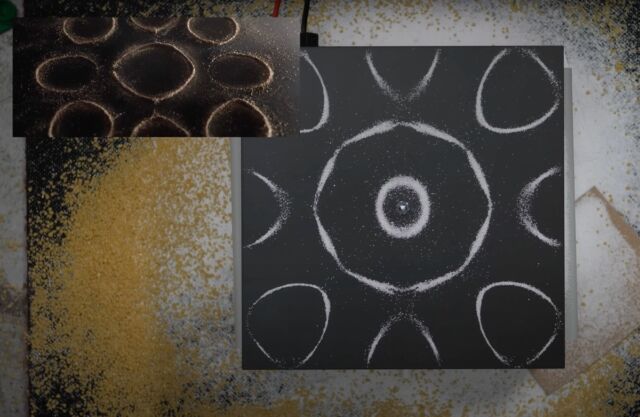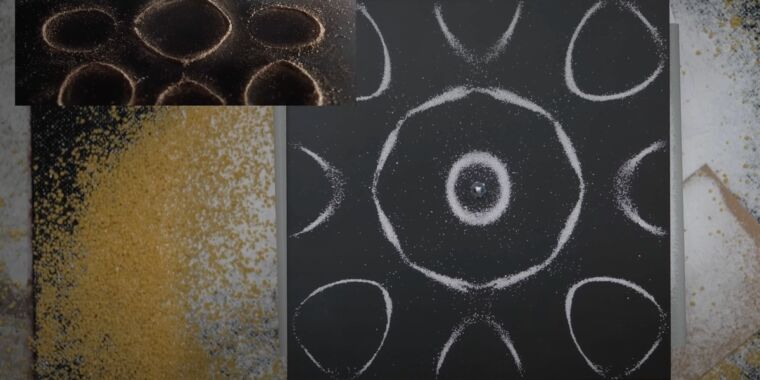Steve Mould re-created The Rings of Power title sequence using patterns produced by vibrating square plates.
The first time I saw the opening credits for The Lord of the Rings: The Rings of Power, I thought the patterns looked remarkably like so-called “Chladni figures“: vibrational patterns that form when one scatters sand on a vibrating plate. It seems I was not the only one. British science communicator and YouTube star Steve Mould got so many comments from viewers about the similarities that he decided to test that hypothesis—by re-creating the title sequence with his own vibration-generated patterns. He documents the journey, and the associated science, in the video above. The final re-created title sequence starts at the 10:55 mark.
The phenomenon is technically known as cymatics. In 1680, Robert Hooke experimented with running a bow along glass plates covered in flour to induce vibrations and noted the telltale nodal patterns that formed in the flour. “A rigid plate will have a set of natural resonance frequencies just like a string, and when the plate is excited at one of these frequencies, it will form a standing wave with fixed nodes,” University of North Carolina physicist Greg Gbur wrote back in 2013. “These nodes will form lines on the plate, in contrast to points on the string.” The flour on the plate made those nodal lines visible.
The 18th century German physicist and musician Ernest Chladni perfected the method 100 years later when he repeated Hooke’s pioneering experiments with circular plates, even demonstrating the effect before Napoleon. The various shapes or patterns created by resonance frequencies are known as “Chladni figures” in his honor. Chladni even came up with a mathematical formula to predict which patterns would form. The higher the rate of oscillation, the more complex those figures will be. Similar methods are still used when designing acoustic instruments: violins, guitars, and cellos, for example.

YouTube/Steve Mould
Mould’s videos explore a wide variety of topics, including one on the physics of the so-called “chain fountain” (rising self-siphoning beads) that inspired two physicists to test his hypothesis and publish a 2014 paper. Mould also created a hugely popular YouTube video in 2016 about the science behind Chladni figures, which he demonstrated by sprinkling couscous on a large vibrating metal square. So he was a natural person to approach for people curious about whether The Rings of Power title sequence had been created in a similar fashion.
First, Mould took a closer look at the specific shapes featured in the title sequence and then tried to figure out how to re-create them (or a similar pattern) using his own vibrating plates, along with the transitions between the patterns. That involved more than little math.
Mould used a program called Desmos to run through various combinations of the two variables at play and the patterns that should be produced on a square plate. (He also experimented with a pentagonal plate for contrast.) Many seemed to match fairly well with patterns in the title sequence. Then he set about trying to make those patterns for real. “I swept through a huge range of frequencies, found a handful that worked really well, and then I coded something up so I could quickly switch between those good frequencies,” Mould says.
The biggest challenge was achieving the distinctive pattern of circles featured at one point in the sequence. This required tweaking the boundary conditions to get different standing waves at different frequencies. Chladni’s original experiment involved a plate that was fixed at the center so that all the patterns had lines that went through that center, which doesn’t move and thus is part of a node line. But in the actual title sequence, that pattern of circles has no lines going through the center. So Mould vibrated the plate from the middle rather than running a bow along the edge, as Chladni did.
In the end, Mould came pretty close to the original pattern of circles, although he suspects it owes a lot to CGI. “Maybe the whole thing is CGI,” he says in the video. “But if it is, I reckon they’re using simulation software for at least some of it to produce those Chladni figures.”
Behind the scenes of The Rings Of Power title sequence.
Listing image by YouTube/Steve Mould









